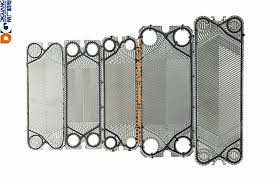Introduction
Plates and gaskets are indispensable components in industrial systems, particularly in plate heat exchangers and sealing applications. Plates are designed to facilitate efficient heat transfer between fluids, while gaskets ensure fluid separation and prevent leaks, maintaining the integrity of the system. Both components are available in a variety of materials to suit specific operational requirements, such as resistance to high temperatures, pressures, and corrosive environments. Their role in optimizing performance and reliability makes them critical in industries like HVAC, power generation, food processing, and chemical production. Understanding their functions and maintenance is essential for ensuring system efficiency and longevity. Plate Heat Exchanger
Plates
Description
- Plates are thin, flat, and typically corrugated components used in systems like plate heat exchangers (PHEs).
- Corrugation Design: The corrugations are designed to enhance turbulence in fluid flow, which maximizes heat transfer efficiency.
- Arrangement: In heat exchangers, plates are stacked with gaskets in between, creating alternating flow channels for two fluids.
Materials
Plates must endure harsh operational conditions, including high temperatures, pressures, and corrosive environments.
- Stainless Steel:
- Widely used due to its corrosion resistance, mechanical strength, and cost-effectiveness.
- Ideal for general industrial use and food processing applications.
- Titanium:
- Preferred for handling seawater or chemically aggressive fluids, as it resists corrosion better than stainless steel.
- Common in marine and chemical industries.
- Nickel Alloys:
- Suitable for extremely corrosive environments, such as those involving acids or alkaline fluids.
- Common in chemical processing and specialized industrial systems.
Functions
- Heat Transfer:
- Plates provide the surface for heat exchange between two fluids, ensuring energy-efficient processes.
- The design maximizes the interaction between fluids, boosting thermal performance.
- Flow Distribution:
- Plates guide the fluids through predefined channels, ensuring even flow and optimal heat transfer.
- Poor flow distribution can lead to inefficiencies and localized overheating or undercooling.
Gaskets
Description
- Gaskets are flexible, sealing components placed between plates to prevent leaks and ensure the integrity of the system.
- They fit precisely into grooves on the plates, ensuring a secure seal under varying pressures and temperatures.
Materials
Gaskets are crafted from materials chosen based on the system’s operating conditions, such as temperature, pressure, and the type of fluids involved.
- EPDM (Ethylene Propylene Diene Monomer):
- Suitable for hot water, steam, and non-oily applications.
- Common in HVAC and food-grade heat exchangers.
- NBR (Nitrile Butadiene Rubber):
- Designed for use with oil-based and petroleum fluids.
- Popular in automotive and industrial systems.
- Viton:
- A fluorocarbon material resistant to high temperatures and aggressive chemicals.
- Ideal for chemical and pharmaceutical applications.
Functions
- Sealing:
- Gaskets form a leak-proof seal between plates, preventing fluid mixing or system leakage.
- Vibration Absorption:
- Gaskets provide a cushioning effect, reducing damage from system vibrations.
- Fluid Isolation:
- They ensure the two fluids remain completely separated, which is crucial in heat exchangers where contamination is a concern.
Applications of Plates and Gaskets
Plate Heat Exchangers (PHEs):
- Widely used in industries like:
- HVAC: For heating and cooling systems in buildings.
- Chemical Processing: To regulate temperatures in reaction systems.
- Power Generation: To cool turbine oils or other process fluids.
Sealing Applications:
- Gaskets are critical in preventing leaks in:
- Pipelines and valves.
- Pumps and mechanical equipment.
Food and Beverage Industry:
- Stainless steel plates paired with food-grade gaskets are used in processes such as pasteurization and chilling, ensuring both hygiene and efficiency.
Marine Industry:
- Titanium Plates: Essential in seawater cooling systems due to their resistance to saltwater corrosion.
Chemical Industry:
- Corrosion-resistant materials: Plates and gaskets are used to handle harsh chemicals in heat exchangers and sealing systems.
Maintenance and Troubleshooting on Plates and Gaskets
Inspection
- Plates: Check for signs of wear, scaling, and corrosion, which can reduce heat transfer efficiency.
- Gaskets: Inspect for cracks, hardening, or deformation, as these can lead to leaks.
Cleaning
- Plates: Use chemical cleaning agents or mechanical cleaning methods to remove deposits and scaling.
- Gaskets: Clean carefully to avoid damaging the sealing material.
Replacement
- Replace damaged or worn-out gaskets periodically to maintain sealing effectiveness.
- Replace warped or corroded plates to avoid performance issues.
Reassembly
- Ensure proper alignment of plates and gaskets during reassembly to prevent leaks or inefficiencies. Tighten clamps or bolts to the manufacturer’s recommended specifications.
Conclusion on Plates and Gaskets
Plates and gaskets form the backbone of many industrial systems, particularly plate heat exchangers, by enabling efficient heat transfer and reliable sealing. Plates provide a large surface area for heat exchange, while gaskets ensure fluid separation and prevent leaks. Their material selection is critical to handling specific operational challenges like high temperatures, pressures, and chemical exposure. Proper maintenance, including regular inspections, cleaning, and replacement, is vital for their longevity and performance. These components, with their adaptability and precision, play a pivotal role in modern industries, ensuring efficiency and reliability in various applications

